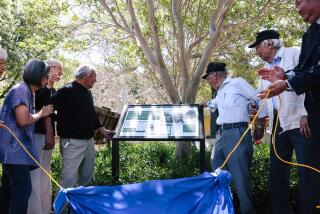Inmate Aborigines Build Australia Hiking Trail
- Share via
ALICE SPRINGS, Australia — Prison inmates sweat heavily under the desert sun, clearing another section of what officials say will be one of the world’s best hiking trails.
But this is no forced-labor chain gang. All are aborigines who put their names on a waiting list to work outdoors for the equivalent of 27 cents a day.
“It’s hot, but being out here is better than jail,” said Sam, who acted as spokesman.
Sam had three months left of an alcohol-related offense and is typical of the men. They are low-risk prisoners--no one with a sex or violence conviction is allowed--and none has tried to escape, despite plenty of chances.
The program started in 1987 under the direction of Tony Bohning, superintendent of prisons for the Northern Territory. His jail in Alice Springs usually holds 130 to 170 prisoners, 80% of them aborigines, with little or nothing to do.
“I had an abundance of prisoners and a lack of work,” he said. “We took trusted prisoners out and worked on the Ghan railway” that runs from Adelaide on the south coast across the Australian Outback to Alice Springs.
Bohning said everyone benefits from the program and he would like to see it extended to other parts of the country.
“The goal is to break the cycle of going to jail, getting released and going to jail again,” he said. “This gives the inmates an inch of a chance to gain some kind of a work ethic and work skills to take back to their communities.”
About half a dozen white inmates have participated since the program began, Bohning said.
When work on the railway was done, the Northern Territory Conservation Department came up with a new project: the Larapinta Trail, to stretch 135 miles from Alice Springs to Mount Zeil, linking seven existing attractions, when it is finished in five years.
The Larapinta, with 13 sections and about 15 access points with water sources, is intended to attract both overnight walkers and long-distance hikers to the newly created West MacDonnells National Park.
“It’ll be a shorter version of the Appalachian Trail in the United States,” said Alan Ginns, senior park planner for the Conservation Department. “Very few people are going to walk it at one shot.”
Ginns said hikers, both Australians and foreigners, have been asking for years for more opportunities to see Australia’s rugged “Red Center” up close.
“But they were terrified of going Outback solo,” he said. “On the Larapinta, there’s something for everybody. We’ve targeted the easier stretches around the more popular attractions.”
Three sections are finished. The first is easy enough for school groups to tackle overnight and already is being hiked by more than 8,000 people a year. Others will be much tougher.
“Some people want it rough,” Ginns said. “It’s part of the Central Australia experience.”
The reddish-orange mountains and cliffs provide breathtaking, constantly changing scenery.
“The geologists say the MacDonnells once were huge, Himalayan-size,” Ginns said. “They’ve been washed down since they were created 600 million to 700 million years ago.”
For each section of trail, the Conservation Department declares a small area to be a prison. The work gang’s trailers--kitchen, workshop, minigym, living quarters and recreation room--are moved in and a fence goes up.
Comparatively little work is done during the Australian summer, December through early February, because of the heat.
Leith Phillips, a park ranger, said the prisoners’ work is of good quality and improves as they gain experience in how to build a trail.
“How fast they can clear the trail depends on the countryside,” he said. “If it’s flat, they can do two kilometers a day. If it’s rough, we’re lucky to get a half-kilometer.”
More to Read
Sign up for The Wild
We’ll help you find the best places to hike, bike and run, as well as the perfect silent spots for meditation and yoga.
You may occasionally receive promotional content from the Los Angeles Times.






